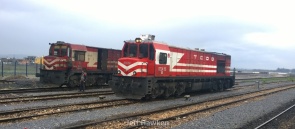For open-access railway operators to be successful, first they must provide a service which the market wants.
There is no point in providing an excellent service if you have no customers for it. Careful research must be done to identify which parts of the market are not well-served by TCDD, and which therefore might benefit from an alternative operator.
The service provided must be different to what is already in the market. So – for example – if TCDD operate two trains per day on a particular route, calling at all stations, then the open access operator might look to run at an entirely different time of day, and possibly providing an express service between the main population centres only, instead of calling at all intermediate stations. Or in the freight market, the open access operator might use a different type of wagon or locomotive to give a greater payload or better transit time.
The timetable must be attractive, but also resource-efficient. A purely resource-led timetable might produce something unattractive to customers, whereas a timetable that meets the exact demands of the customer might be very resource-intensive (i.e. requiring additional rolling stock and train crews) so as to become unaffordable. So this has to be a compromise.
Finally, the price charged to the customer must be competitive. If the service provided is significantly better than that which TCDD can provide itself, then it might be possible to charge a premium. Otherwise it is often the case that open access fares and freight tariffs may be lower than the national carrier, in order to attract customers.
There does need to be some regulation of open access operation, to prevent operators simply “cherry-picking” the most attractive traffic flows, leaving TCDD with low-paying low-volume traffic only. The open access operator must be seen to be increasing rail’s market share: simply moving the same traffic at a cheaper price doesn’t do anybody much good.
So who benefits from Open Access?
Firstly, the customers of the railway – both existing and new – are given a wider range of choice in terms of service quality and pricing. So they can choose which train operator to use. Competition such as this often has the effect of causing both operators to improve their service to the customers.
The railway infrastructure owner benefits as they receive additional income because of the additional trains running.
There is an overall environmental benefit by moving more people off airlines and roads onto rail, and the same with freight traffic.
Finally, the effect on the railway staff can be mixed. If the effect is to increase the amount of traffic carried (as has been the case in the UK) then more staff are employed. However their conditions of service may not be the same as on TCDD, in respect of wages, hours worked, and fringe benefits. Train staff may be required to work longer hours, but are often better paid as a result.
Cover Photo: Jeff Hawken ©
Categories: Railway Companies









Thanks Jeff,
Interesting article. This is an ongoing debate in the UK, of course, so it will be interesting to what happens here.
Hi Steve,
Yes, in the UK the orthodox view is that “competition” is inherently a “good thing” as it promotes better customer service, and reduces prices. But how realistic is competition when you are reliant upon the availability of a scarce asset – such as railway capacity?
I think the outcome for Turkey might be different for passenger and freight. I see freight open access as being potentially quite successful, but passenger open access is unlikely to be viable.
Interesting times ahead!
Hello,
Would you know the Track Access Charge for a passenger train in Turkey ?
Thanks !